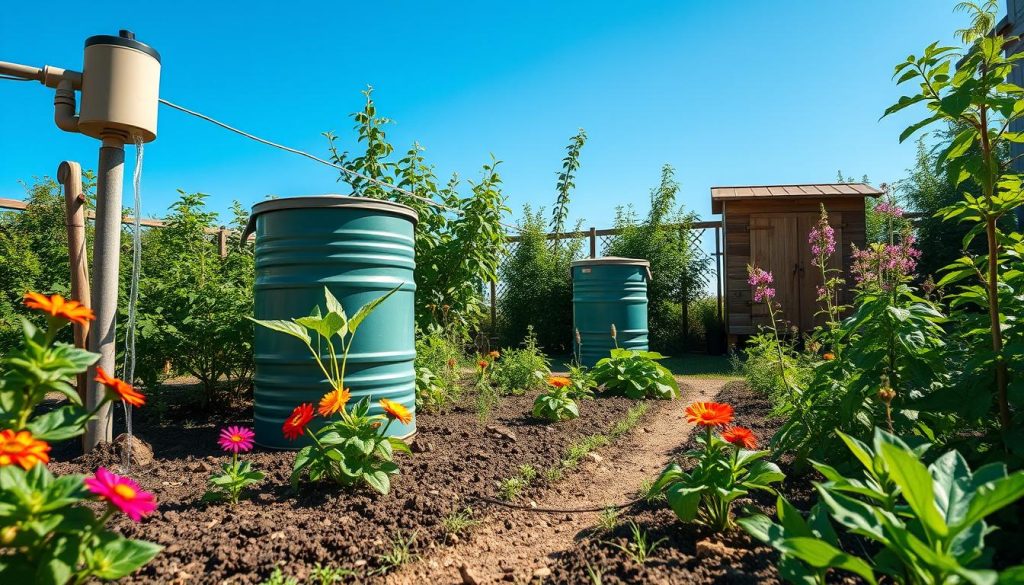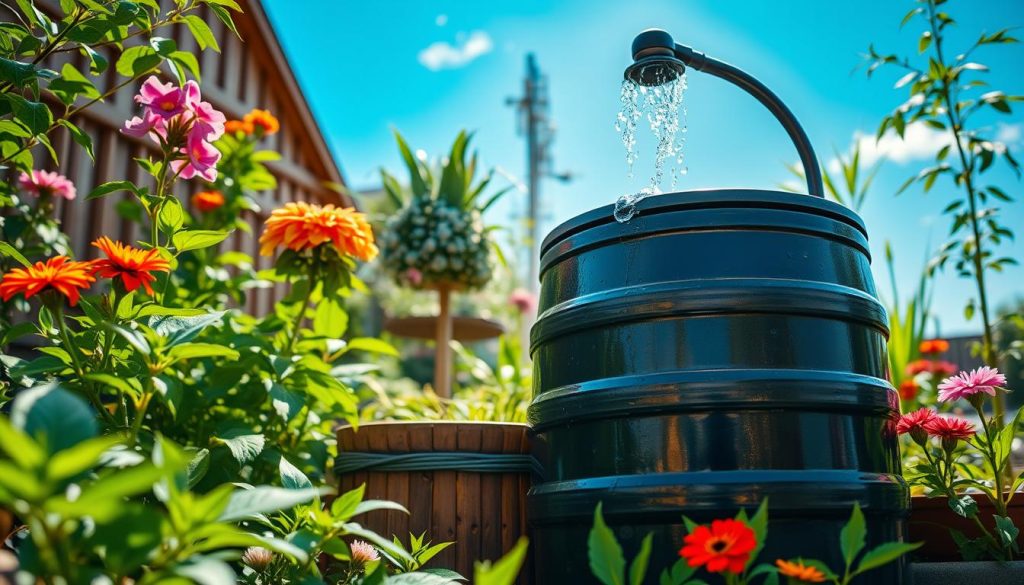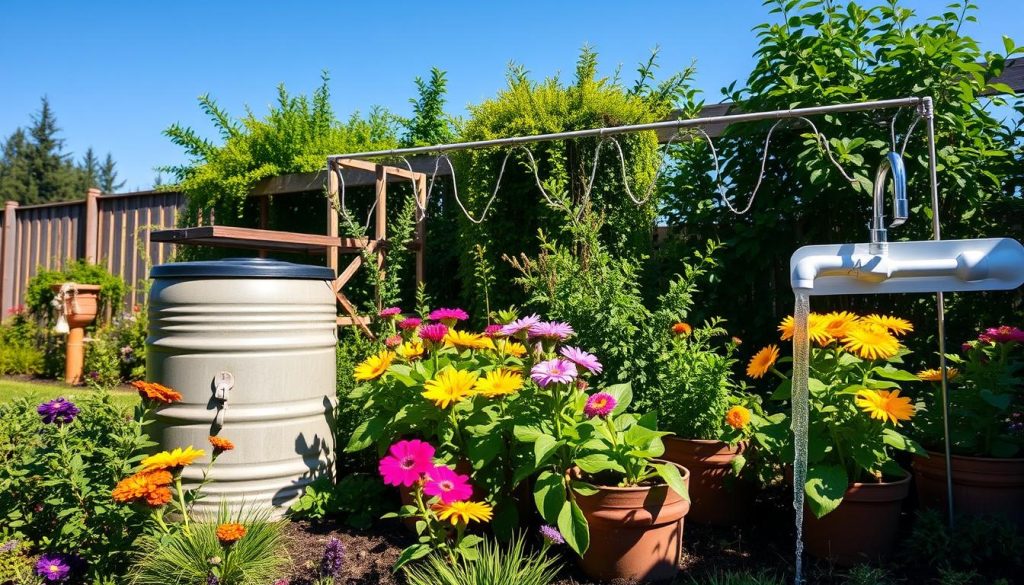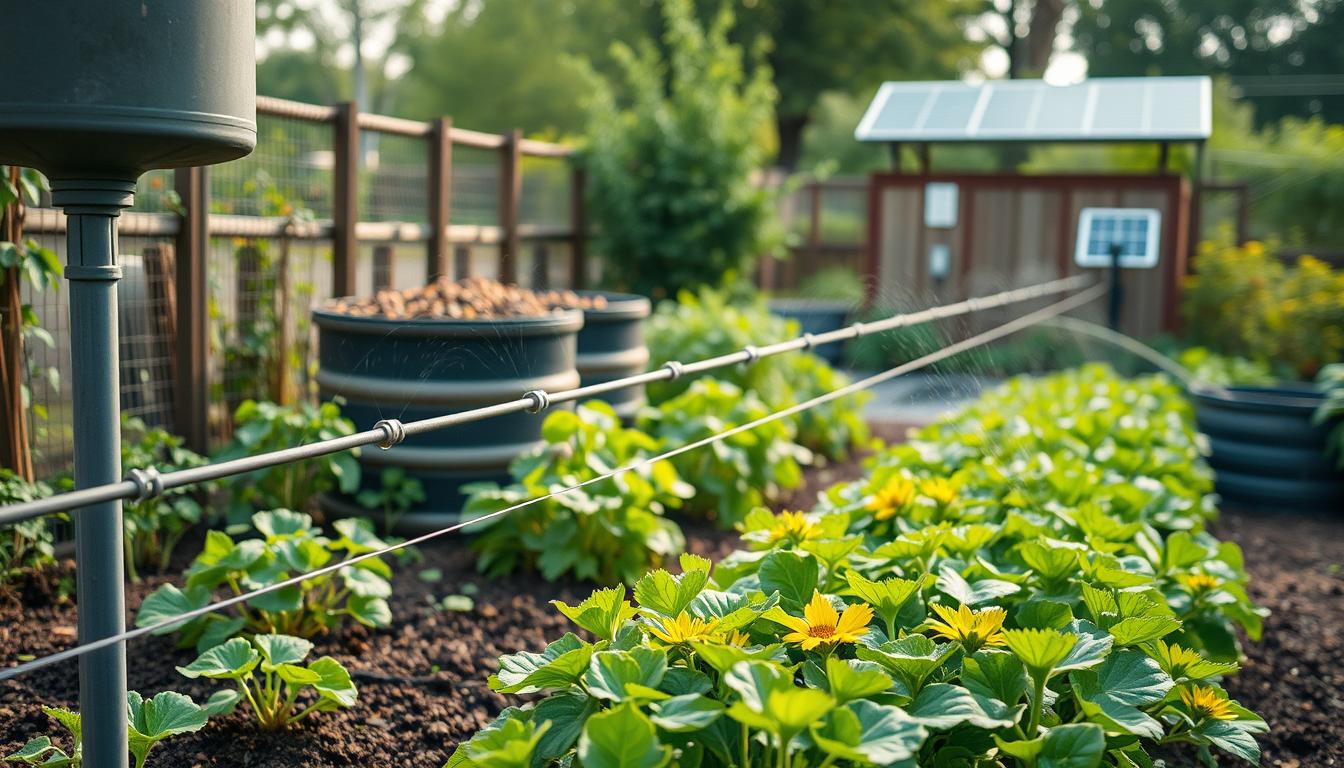I’m passionate about protecting the environment, especially when it comes to watering plants. Traditional methods waste a lot of water, with much of it becoming runoff or evaporation. So, I’ve been looking into eco-friendly ways to water my plants.
Using sustainable irrigation methods helps us waste less water and live more sustainably. These practices are not only good for the planet but also for my plants. In this article, I’ll share tips on how to use these methods in your garden.
I think we can all make a difference by working together. By using eco-friendly watering practices and sustainable irrigation, we can cut down on water waste. This helps protect our planet for the future.
Understanding Zero-Waste Watering Techniques
Exploring eco-friendly gardening, I’ve learned the value of water-efficient tips and green irrigation. These steps help cut down water use and make my garden sustainable. Zero-waste watering means using methods that save water and lessen gardening’s environmental footprint.
This includes collecting rainwater and using drip irrigation. Starting is key, and understanding zero-waste’s benefits and myths is crucial. Many think it’s hard or pricey, but it’s not.
What is Zero-Waste Watering?
Zero-waste watering is a gardening way to cut down water waste and lessen environmental harm. It uses efficient watering tips and green irrigation, like drip systems and rainwater collection.
The Benefits of Going Zero-Waste
Adopting zero-waste watering brings many perks, like lower water bills and a greener garden. Key benefits include:
- Less water use
- Lower water bills
- A greener garden
- Bigger crop yields

Common Myths About Zero-Waste Practices
Despite its advantages, zero-waste watering faces myths and misconceptions. Learning the truth helps me make better gardening choices. This way, I can help my garden’s future.
Simple Ways to Collect Rainwater
Collecting rainwater is a great way to water your garden without waste. It helps save money on your water bill and gives your plants a natural water source. You can start by using a rain barrel or decorative containers.
Creating a rainwater collection system can be both useful and beautiful. For instance, you can use a container as a planter and a rainwater collector. This adds elegance to your garden while cutting down on water waste.
Setting Up a Rain Barrel
To set up a rain barrel, you’ll need a few basic items. These include a large container, a spigot, and a downspout diverter. You can find these at a hardware store or online.
Using Decorative Containers
Decorative containers are a fantastic way to collect rainwater and beautify your garden. You can pick from various containers like ceramic pots or wooden barrels. This creates a unique and useful rainwater collection system.

Maintaining Your Rainwater System
To keep your rainwater system working well, regular maintenance is key. This includes cleaning the containers and checking for leaks. By doing these simple tasks, you can make a green watering solution that works well and lasts.
- Check the containers regularly for debris and sediment
- Use a first flush device to divert the first flow of water from the roof
- Install a mosquito screen to prevent mosquito breeding
Efficient Watering Methods for Plants
I’ve been looking for ways to use less water in my garden. I’ve learned that using water wisely is key. Drip irrigation systems are great because they water plants right at the roots. This cuts down on water lost to evaporation and runoff.
When I water, I do it in the early morning or evening. This helps prevent water from evaporating quickly. Here are some more tips for watering wisely:
- Water plants deeply but infrequently to encourage deep root growth
- Use mulch to retain soil moisture and reduce evaporation
- Monitor soil moisture by inserting a finger into the soil or using a soil probe
By using these smart watering methods, my garden is not only beautiful but also helps the environment.
Drip Irrigation Systems
Drip irrigation systems are perfect for getting water to my plants’ roots. They have tubes and drippers that slowly release water. This keeps my plants watered consistently.
Timing Watering for Maximum Efficiency
Watering at the right time is crucial for my plants. I water in the morning or evening to cut down on evaporation. This makes my watering schedule more efficient and helps the planet.
Creative Ways to Reuse Household Water
I’ve found many creative ways to reuse household water. By using sustainable irrigation, we can cut down on water waste. One easy start is to collect cooking water or shower water for our gardens.
Here are a few ways to reuse household water:
- Collecting cooking water: This can be as simple as collecting the water used to boil vegetables or steam food.
- Capturing shower water: Installing a grey water system can provide a constant source of water for our plants.
- Using water from pet bowls: Even this water can be reused, reducing the amount of wastewater that ends up in the sewer system.
By using these eco-friendly watering practices, we can greatly reduce water waste. Sustainable irrigation, like grey water systems, gives plants a steady water supply. 
Every small change helps a lot in reducing water waste. By adopting eco-friendly watering and sustainable irrigation, we can make our gardens more sustainable. This also helps the environment.
Tips for Maintaining Healthy Plants Without Waste
As we wrap up our journey into water-efficient gardening, it’s essential to focus on maintaining healthy plants without waste. Mulching is a game-changer when it comes to retaining soil moisture, reducing the need for frequent watering. By applying a layer of organic material around your plants, you’ll lock in precious water and minimize evaporation.
Another key strategy is choosing native plants that are naturally adapted to the local climate. These resilient species require less water and thrive with minimal maintenance. They are the perfect choice for an environmentally conscious irrigation system.
In addition to these water-efficient gardening tips, regularly monitoring soil health is crucial. Using a soil moisture meter, you can ensure your plants receive the right amount of water at the right time. This practice not only promotes plant health but also helps conserve precious water resources.
By adopting these simple yet impactful techniques, you can create a thriving, sustainable garden. This garden not only reduces waste but also provides a haven for local wildlife.

